
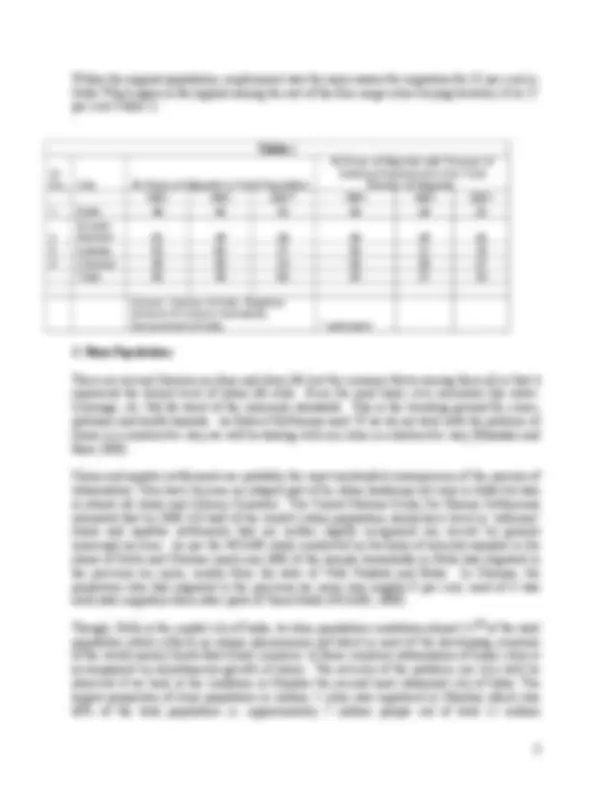
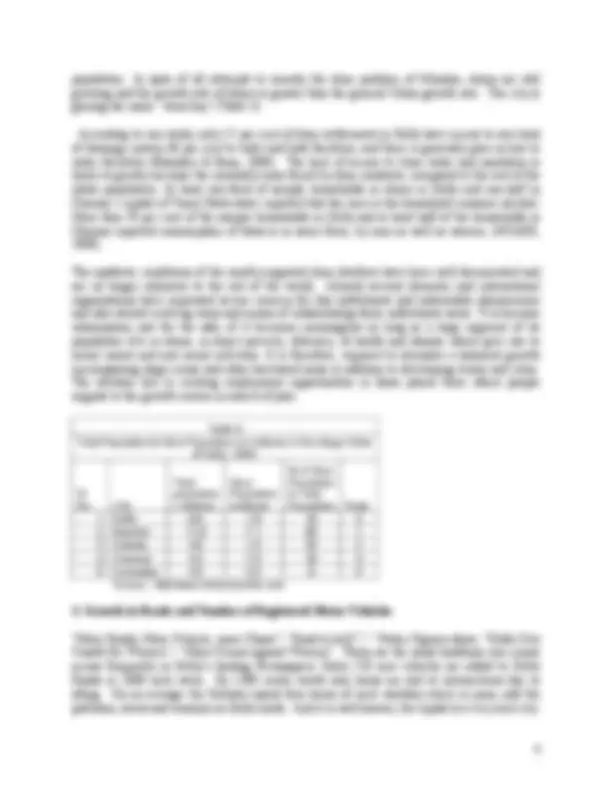
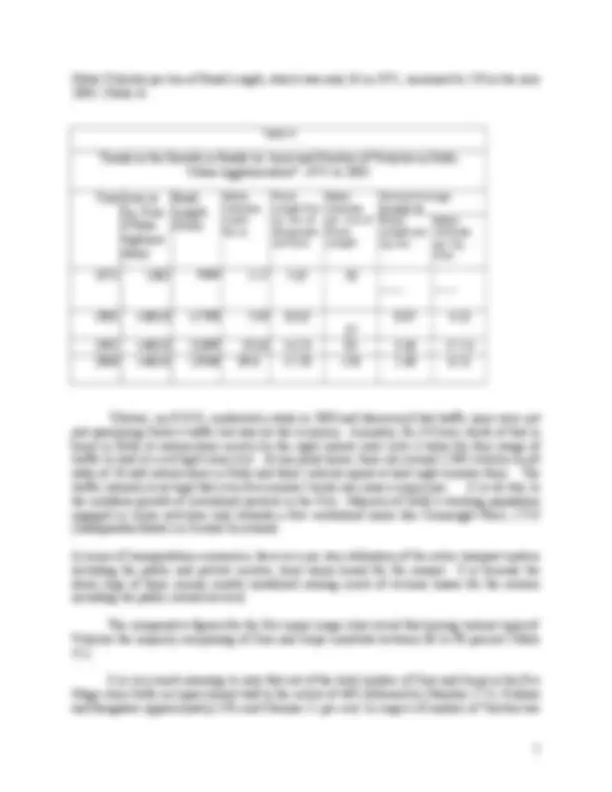
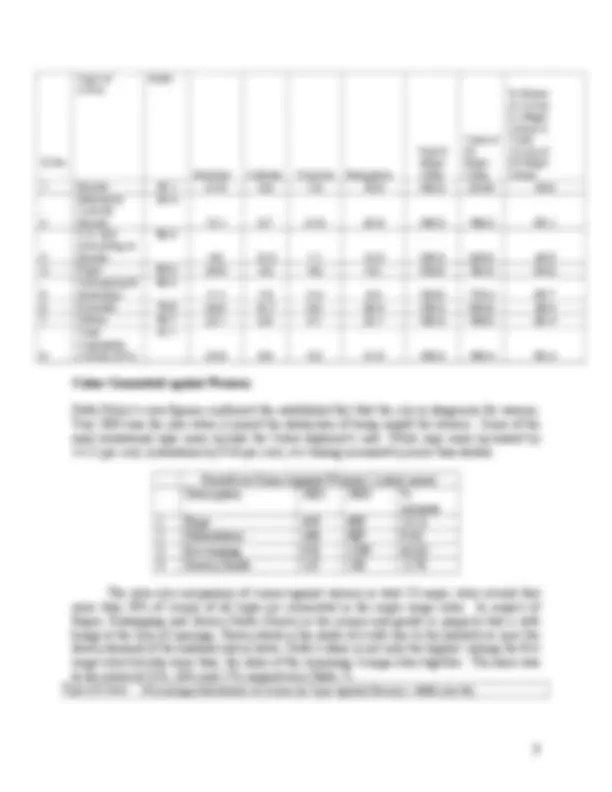
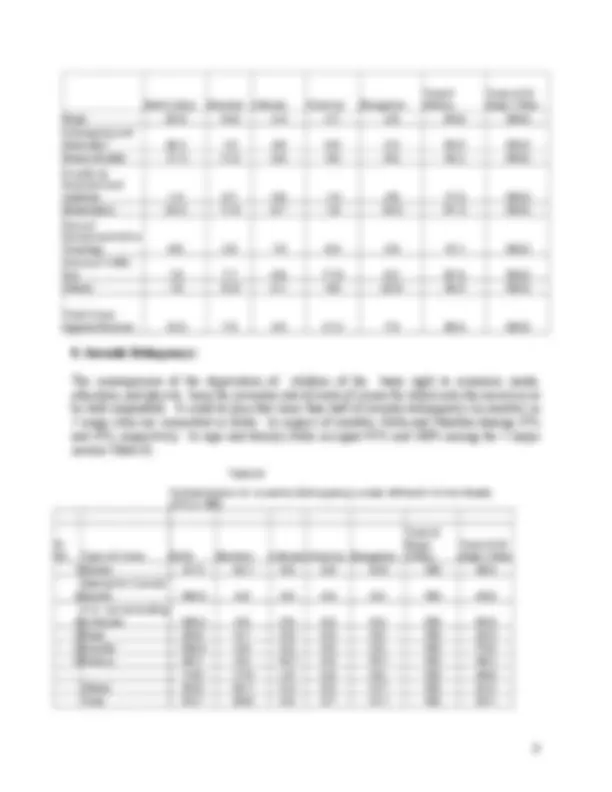
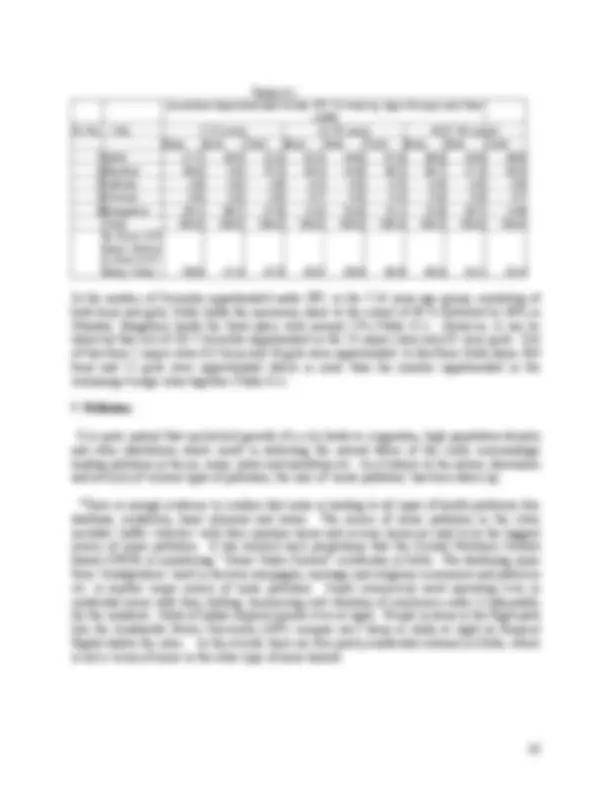
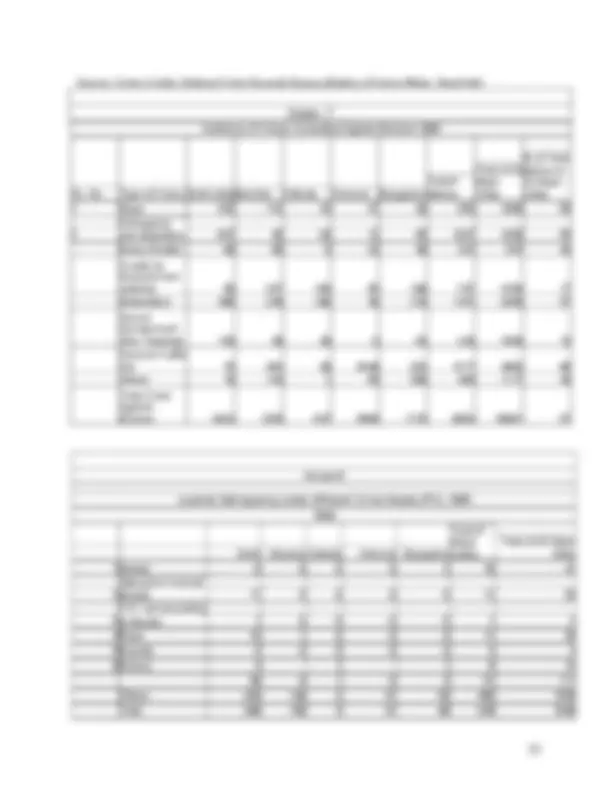

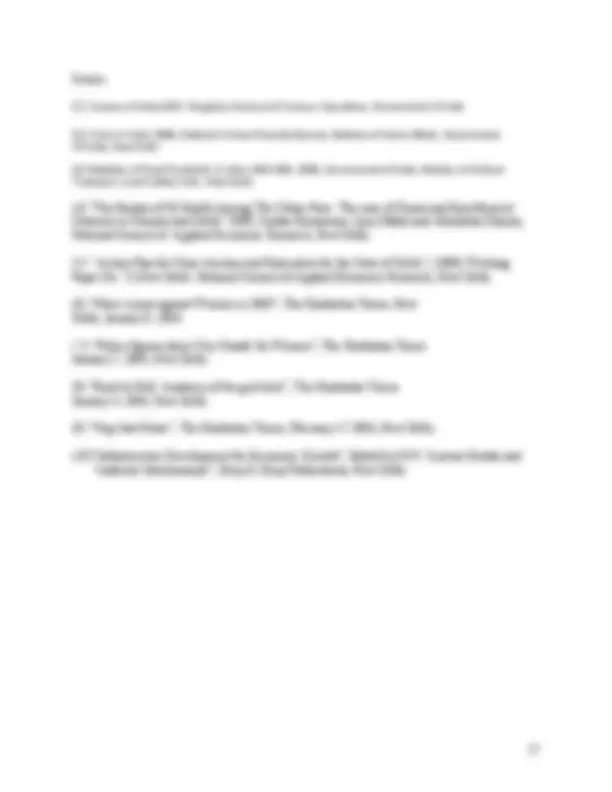


Study with the several resources on Docsity

Earn points by helping other students or get them with a premium plan


Prepare for your exams
Study with the several resources on Docsity

Earn points to download
Earn points by helping other students or get them with a premium plan
Community
Ask the community for help and clear up your study doubts
Discover the best universities in your country according to Docsity users
Free resources
Download our free guides on studying techniques, anxiety management strategies, and thesis advice from Docsity tutors
An analysis of the urbanization and crime issues in the five major metropolitan cities of India - Delhi, Mumbai, Kolkata, Chennai, and Bangalore. It discusses the percentage share of migrant population, reasons for migration, employment statistics, and crime rates in these cities. The document also includes data on road growth, registered motor vehicles, and accidents.
What you will learn
Typology: Lecture notes
1 / 15

This page cannot be seen from the preview
Don't miss anything!










Area (Sq.Kms) Population (millions) Density in Sq Kms of Geographical Area
Sl. No
Municipal Corporation
Decenni al growth % ( over
Annual Average growth (%) 1991 to 2001
Rank
Rank
1 Delhi 12397 12397 7.2 9.8 36.2 3.6 2 581 792 5
2 Mumbai 438 438 9.9 11.9 20.0 2.0 3 22677 27202 1
3 Kolkata 185 185 4.4 4.6 4.1 0.4 4 23733 24760 2 4 Chennai 174 174 3.8 4.2 9.8 1.0 5 22077 24231 3 5 Bangalore 126 225 2.7 4.3 61.4 6.1 1 21112 19077 4
Table 3 Total Population & Slum Population (in millions) in five Mega Cities of India – 2001
Sl. No. City
Total population ( millions)
Slum Population (millions)
% of Slum Population to Total Population Rank 1 Delhi 9.8 1.8 19 3 2 Mumbai 11.9 7.1 60 1 3 Kolkata 4.6 1.5 33 2 4 Chennai 4.2 7.5 18 4 5 Karnataka 4.3 3.5 8 5 Source: http//www.indiaurbaninfo.com
Table 4
Annual Average Growth %
Motor Vehicles (Lakh No.s)
Road Length Per sq. Km of Geographi cal Area
Motor Vehicles per Km.of Road Length
Road Length per Sq Km
Motor Vehicles per Sq. Kms
Source: Statistics of road Accidents in India (1991-98), 2000, Government of India, Ministry of Surface Transport (road Safety Cell) , New Delhi.
Table 5. Percentage of Persons Killed with respect of Number of Road Accidents in Major Metros of India Sl. No. Year Delhi Mumbai Kolkata Chennai Total 3 1991 22.0 1.4 4.5 12.2 6. 4 1992 20.3 5.2 5.6 12.3 10. 5 1993 21.0 4.8 6.2 10.0 10. 6 1994 20.8 1.3 6.2 10.0 6. 7 1995 20.4 1.4 5.4 11.1 6. 8 1996 20.9 1.4 5.1 11.3 6. 9 1997 21.4 1.5 4.6 14.5 7. 10 1998 20.8 1.4 4.1 13.3 6. Source: Statistics of road Accidents in India (1991-98), 2000, Government of India, Ministry of Surface Transport (road Safety Cell) , New Delhi.
Percentage Share of Cognizable Crimes Under Indian Panel Code (IPC) By Type in Five Mega cities of India- 1999 (row %)
Sl.No .
Type of Crime
Delhi
Mumbai Kolkata Chennai Bangalore
Total 5 Mega Cities
Total of 23 Major Cities
% Share of Crime in Mega Cities in Total Crime of 23 Major Cities 1 Murder^ 42.1^ 27.8 5.9 7.6 16.6 100.0 224.8 44.
Attempt to Commit Murder
C.H. Not amounting to Murder
4 Rape^ 60.0^ 25.5 4.3 4.9 5.2 100.0 182.3 54.
5
Kidnapping & Abduction
6 Doacoity^ 18.8^ 33.0 10.7 8.0 29.5 100.0 205.8 48. 7 Others^ 40.7^ 23.1 9.0 5.1 22.1 100.0 198.5 50.
Total Cognigible Crimes (IPC)
Type of Crime (^) Percentage Distribution of Crimes by Type Against Women –1999 (row %)
Juveniles Apprehended Under IPC Crimes by Age Groups and Sex
Sl. No. City 7-12 years 12-16 years All (7-16 years) Boys Girls Total Boys Girls Total Boys Girls Total 1 Delhi 21.7 33.3 22.2 52.3 44.0 51.9 48.9 42.9 48. 2Mumbai 49.3 0.0 47.2 28.4 24.0 28.2 30.7 21.4 30. 3Kolkata 2.9 0.0 2.8 0.4 0.0 0.3 0.6 0.0 0. 4Chinnai 0.0 0.0 0.0 6.7 0.0 6.4 5.9 0.0 5. 5Bangalore 26.1 66.7 27.8 12.3 32.0 13.1 13.8 35.7 14. Total 100.0 100.0 100.0 100.0 100.0 100.0 100.0 100.0 100. % Share of 5 Major Metros in total of 23 Major Cities 38.8 21.4 37.5 35.5 36.8 35.6 35.9 34.1 33.
Total Number of Population, Total Number of Migrants and Migrants for the Purpose of Seeking Employment
Total Populati on
Total Migrants
Total Population
Total Migrants
Total Population
Total Migrants
Employment as purpose of Migrataion 1 Delhi 6220406 2989121 9420644 3723462 13791458 4457803 832030 1083597
Greater Mumbai 8243405 4242298 9925891 4436167 16368084 4630036 1646689 1227329 3 Kolkata 3305006 1709877 4399819 2617626 13216546 3525375 517764 543395 4 Chennai 3276622 1478525 3841396 1498195 6424624 1517865 415903 414746
Total
No. of Registered Transport Motor Vehicles by Type in 5 Metros of India-1999-
Sl. No. Type of Vehicle Delhi
Mumba i
Kolkat a
Chenna i Bangalore Total
Source: Crime in India, National Crime Records Bureau,Ministry of Home Affairs, New Delhi.
Incidence of Crimes Committed Against Women-
SL. No Type of Crime Delhi (city) Mumbai Kolkata Chennai Bangalore
Total 5 Metros
Total of 23 Major Cities
% of Total Metros to 23 Major Cities
1 Rape 332 141 24 27 29 553 1008 55
Kidnapping and Abduction 837 30 93 12 65 1037 1939 53 Dowry Deaths 95 60 5 22 49 231 547 42 Cruelty by Husband and relatives 58 237 159 55 198 707 4156 17 Molestation 480 243 199 40 219 1181 2059 57 Sexual Harrassment (Eve Teasing) 126 36 28 0 52 242 1845 13 Immoral Traffic Act 76 362 38 3349 292 4117 4683 88 Others 18 144 1 55 266 484 1117 43 Total Crime Against Women 2022 1253 547 3560 1170 8552 16807 51
Annex-
Juvenile Delinquency under different Crime Heads (IPC)- 1999 1999
Delhi Mumbai Kolkata Chennai Bangalore
Total ( Mega Cities)
Total of 23 Major Cities 1 Murder 9 8 0 0 2 19 41
Attempt to Commit Murder 11 0 0 0 0 11 25
C.H. not amounting to Murder 1 0 0 0 0 1 2 4 Rape 10 1 0 0 0 11 26 5 Dacoity 3 0 0 0 0 3 4 6 Robery 4 1 1 6 13 38 9 1 0 3 51 111 Others 250 149 2 31 63 495 1538 Total 288 158 3 31 66 546 1649
Sl.
- Annex 8. - Juveniles Apprehended Under IPC Crimes by Age Groups and Sex –